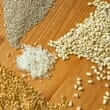Background
- Chia (Salvia hispanica L.) is a plant that belongs to the Lamiaceae (mint) family. Chia is believed to have come from Central America where the chia seed was considered a staple in the ancient Aztec diet. Native Americans in the southwestern United States used the seeds of a related plant, "golden chia" or Salva columbariae. People in China and other countries use the roots of another relative, "dan shen" or Salvia miltiorrhiza, for medicinal purposes.
- Chia is promoted for its high omega-3, omega-6, and omega-9 content. Animal studies suggest that chia may lower blood cholesterol, LDL (low density lipoproteins or "bad" cholesterol), and triglycerides while increasing HDL (high density lipoproteins or "good" cholesterol). Chia may also have anti-cancer activity. Studies in humans are limited.
- Salba® is a registered variety of chia that is marketed by Core Naturals, LLC. Light in color, Salba® reportedly contains more omega-3 fatty acids than typical dark-colored chia seeds. Recent human studies suggest that Salba® may decrease the risk of heart disease in people with type 2 diabetes.
References
Natural Standard developed the above evidence-based information based on a thorough systematic review of the available scientific articles. For comprehensive information about alternative and complementary therapies on the professional level, go to . Selected references are listed below.
- Adams JD, Wall M, Garcia C. Salvia columbariae contains tanshinones. Evid Based Complement Alternat.Med 2005;2(1):107-110.
View Abstract - Adams JD, Wang R, Yang J, et al. Preclinical and clinical examinations of Salvia miltiorrhiza and its tanshinones in ischemic conditions. Chin Med 2006;1:3.
View Abstract - Ayerza R, Coates W, Lauria M. Chia seed (Salvia hispanica L.) as an omega-3 fatty acid source for broilers: influence on fatty acid composition, cholesterol and fat content of white and dark meats, growth performance, and sensory characteristics. Poult Sci 2002;81(6):826-837.
View Abstract - Ayerza R Jr, Coates W. Effect of dietary alpha-linolenic fatty acid derived from chia when fed as ground seed, whole seed and oil on lipid content and fatty acid composition of rat plasma. Ann Nutr Metab 2007;51(1):27-34.
View Abstract - Espada CE, Berra MA, Martinez MJ, et al. Effect of Chia oil (Salvia Hispanica) rich in omega-3 fatty acids on the eicosanoid release, apoptosis and T-lymphocyte tumor infiltration in a murine mammary gland adenocarcinoma. Prostaglandins Leukot Essent Fatty Acids 2007;77(1):21-28.
View Abstract - Fan TP, Yeh JC, Leung KW, et al. Angiogenesis: from plants to blood vessels. Trends Pharmacol Sci 2006;27(6):297-309.
View Abstract - Hu Z, Yang X, Ho PC, et al. Herb-drug interactions: a literature review. Drugs 2005;65(9):1239-1282.
View Abstract - Jiang RW, Lau KM, Hon PM, et al. Chemistry and biological activities of caffeic acid derivatives from Salvia miltiorrhiza. Curr Med Chem 2005;12(2):237-246.
View Abstract - Reyes-Caudillo E, Tecante A, Valdivia-López MA. Dietary fibre content and antioxidant activity of phenolic compounds present in Mexican chia (Salvia hispanica L.) seeds. Food Chemistry 2008;107(2):656-663.
- Vuksan V, Whitham D, Sievenpiper JL, et al. Supplementation of conventional therapy with the novel grain Salba (Salvia hispanica L.) improves major and emerging cardiovascular risk factors in type 2 diabetes: results of a randomized controlled trial. Diabetes Care 2007;30(11):2804-2810.
View Abstract - Wang X, Morris-Natschke SL, Lee KH. New developments in the chemistry and biology of the bioactive constituents of Tanshen. Med Res Rev 2007;27(1):133-148.
View Abstract - Wojcikowski K, Johnson DW, Gobe G. Herbs or natural substances as complementary therapies for chronic kidney disease: ideas for future studies. J Lab Clin Med 2006;147(4):160-166.
View Abstract - Xu BJ, Zheng YN, Sung CK. Natural medicines for alcoholism treatment: a review. Drug Alcohol Rev 2005;24(6):525-536.
View Abstract - Zhang XP, Li ZJ, Liu DR. Progress in research into the mechanism of Radix salviae miltiorrhizae in treatment of acute pancreatitis. Hepatobiliary Pancreat Dis Int 2006;5(4):501-504.
View Abstract - Zhou L, Zuo Z, Chow MS. Danshen: an overview of its chemistry, pharmacology, pharmacokinetics, and clinical use. J Clin Pharmacol 2005;45(12):1345-1359.
View Abstract







